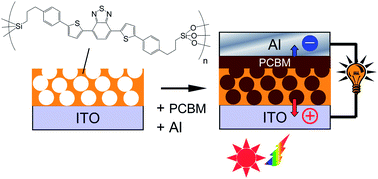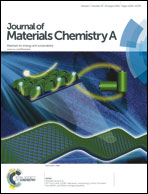Synthesis of visible-light-absorptive and hole-transporting periodic mesoporous organosilica thin films for organic solar cells†
Abstract
Periodic mesoporous organosilica (PMO) thin films that possess both visible-light absorption and hole-transporting properties were synthesized from a newly designed 4,7-dithienyl-2,1,3-benzothiadiazole (DTBT)-bridged organosilane precursor using polystyrene-block-poly(ethylene oxide) (PS-b-PEO) as a template. DTBT-based PMO films were successfully obtained from the 100% organosilane precursor without the addition of other alkoxysilanes such as tetraethyoxysilane and by control of the tetrahydrofuran–ethanol solvent ratio and the PS/PEO group ratio in the block copolymer. The PMO films possess connected cage-like mesopores with diameters of ca. 15–20 nm, which could be derived from templating with spherical micelles. The PMO films exhibited absorption in the visible range between 400 and 650 nm and hole-transport mobility in the order of 10−5 cm2 V−1 s−1. We demonstrate that the PMO thin film functions as a p-type layer for organic solar cells by filling an n-type [6,6]-phenyl C61 butyric acid methyl ester into the mesopores.


 Please wait while we load your content...
Please wait while we load your content...